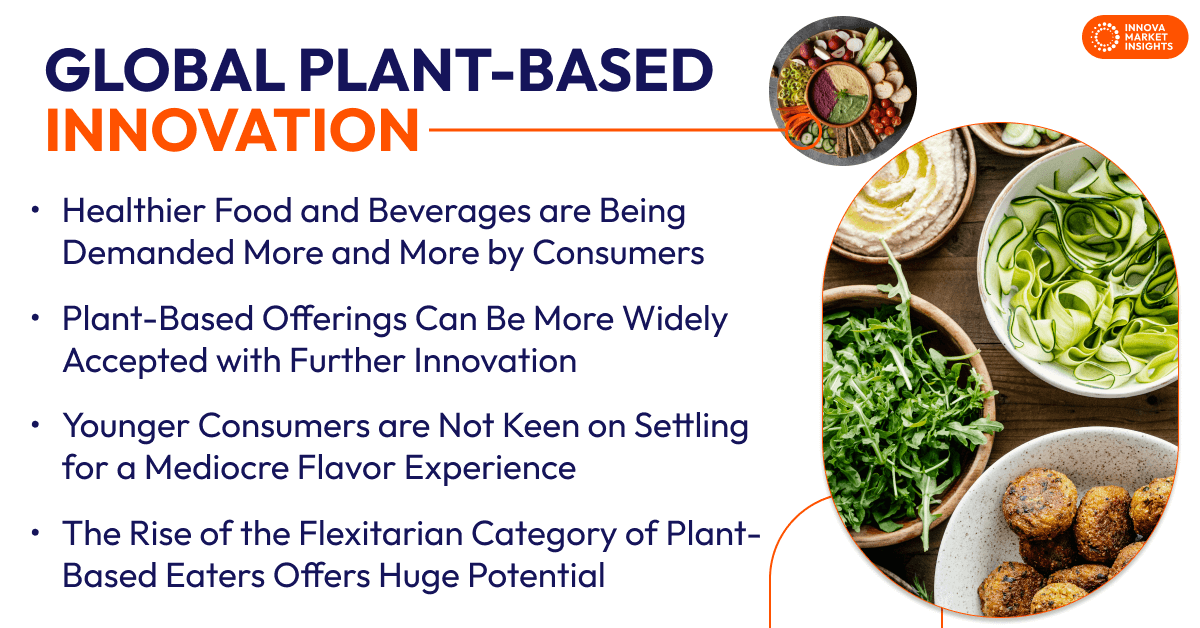October 8, 2025 – As plant-based food and beverages become more common, a varying degree of factors are shaping the category. From soups to ready meals, seasonings to sauces, global growth in plant-based eating is happening. To dive into this topic and understand the influences in consumption, Innova Market Insights has put together research around the shift in diets, expectations for taste, and flavor innovation.
What is Driving Plant-Based Innovation?
Plant-based trends reveal that healthier food and beverages are being demanded more and more by consumers. Various products across categories target goals of reducing meat or dairy-based offerings to appeal to new consumption habits. Conscious choices are made among the aisles, and the mindful shopper takes considerations of climate awareness seriously. From climate change consequences of factory farming practices, there has been a shift towards more sustainable choices, particularly among Generation Z and Millennial consumers. Flexitarians have become a new group who are balancing eating meat-based food to increase their plant-based dietary choices without completely committing to vegetarianism. This is, by and large, the reason for momentum in innovation efforts around more satisfying, plant-based and vegetarian eating habits.
The industry is maturing, and the pace at which research and technology are growing shows positive signs. Although barriers do exist in areas such as protein, where preferences are defined by culinary choice and geographical positioning. This means the swing of poultry, seafood, and red meat varies, and replicating that is a challenge.
Is There a Gap Between Expectations and Flavor-Focused Options?
For 30% of consumers globally, the lack of taste or flavor is a negative characteristic often associated with plant-based, vegetarian, or vegan foods. This is a clear indication that there is still work to be done. While many believe that this will improve, it does indicate that the rate of innovation needs to gather pace. In this report, analysis of selected product categories yielded low percentages of launches across flavor categories and subcategories. The conclusion is that opening the door to further innovation in flavor or format can improve consumer perception across regional cuisines, better-for-you offerings, culinary cross-category fusions, and more. Producers who do not follow the trend are likely to fall behind in this regard.
Can Occasions and Formats Shape Plant-Based Flavor Innovation?
Plant-based trends show that offerings are in a position to be more widely accepted with further innovation. Flavor development can spark something in the category by replicating meat or dairy-based tastes with alternative ingredients. Beyond the phase of just offering a substitute for meat in their product lines. Companies now have an opportunity to run with experimental flavors or formats for various occasions in ready meals, social gatherings. Or new twists on traditional foods across regions.
Further to this, the adoption of plant-based products across categories helps consumers to feel better through healthier eating. This can be observed in the proliferation of almond-based milks and many others, such as oat, soy, and coconut, to name a few. Flavor innovation makes dairy alternatives (more so liquids) unexpectedly more versatile in this sense.

Do Flavors with Function Have Wellness Benefits?
Plant-based trends indicate that younger consumers are not keen on settling for a mediocre flavor experience, largely due to the influences of personality and technology on what they should expect. Plant-based food needs flavors that are rich, bold and authentic of the region that has influenced the food they consume. Such complexity in the taste and ingredient choices means that the category is no longer about simple launches but instead about evocative variety and specificity of components. The same goes for wellness, where flavors with function such as turmeric or green tea may be paired with other flavors, or childhood favorite flavors may be melded with better-for-you ingredients to give a premium feel.
What Choices are Younger Generations Making?
Research by Innova Market Insights found that 23% of consumers globally claim to have looked for new or novel flavors in the snacks category in the past twelve months. That is a considerable amount, and for innovative brands, the opportunity is there. In the last five years, snacks labeled as vegan have made up 40% or more of all new snack launches. However, snacks with vegetarian and plant-based labels are growing at rates that are at least twice as fast as those for vegan snacks.
Although there exists a more specific gap for potential in non-dairy drinks, almost a third of Generation Z consumers said that they are ready to try more flavors. That was nearly double the percentage of Boomers who claimed the same. Younger consumers who are still at an experimental stage of their taste adventure need more than comfortable innovation launches. Instead, they could be offered unique flavors that combine sweet and savory flavors that offer exotic authenticity or functional snacks with a more global twist.
Can Flavor Innovation in Plant-Based Foods Evolve?
When it comes to innovation for flavor in snacks and ready meals, Mediterranean, Asian, and Indian Masala flavors still account for a relatively small share of launches. Therefore, there is a wealth of choice out there from which new flavors can be created or inspired by. The key for manufacturers will be to focus on authentic flavor with influence from regions. A quarter or more of consumers globally said they have looked for flavors that are familiar to them or traditional for their culture across the categories of savory snacks, soups, ready meals, and seasonings.
If you look closer at ready meals as an example, vegetarian claims dominated the category for the five years, with around 60% of launches. So for ready meals, there is a captive audience for people interested in exploring new types of protein and curious about new tastes. Elsewhere, familiar and traditional flavor types with spicy or sweet notes top consumer preferences. This makes sauces and seasonings a logical category for experimentation. Last but not least, soups have an important role to play, as the shift from wet soup formulation to dry shows brands and consumers are focused on value, versatility, and smaller sizes. For 34% of consumers around the world, the feeling is that plant-based products are expensive. Plant-based trends show that the shift to dry soups helps lower prices since they do not need special packaging and have a longer shelf life. This gives consumers more choice and flexibility.
What’s Next for Plant-Based Innovation Globally?
For global plant-based innovation, the rise of the flexitarian category of plant-based eaters offers huge potential. This can happen with the continued expansion of poultry and seafood flavors in the meat substitutes category. This is not the only potentially relevant category for such alternatives to excel in. Crossovers with comfort food derived from plants with unique and functional characteristics will be where the category will shine most based on findings from this report. Sweet and savory hybrid offerings representing a broader range of regional cuisines can have an enormous impact, while better-for-you ingredients and claims across categories in established flavors will give a new life to an already known selection of products.
This article is based on Innova’s Plant-Based Innovation – Global report. This report is available to purchase or with an Innova Reports subscription. Reach out to find out more
